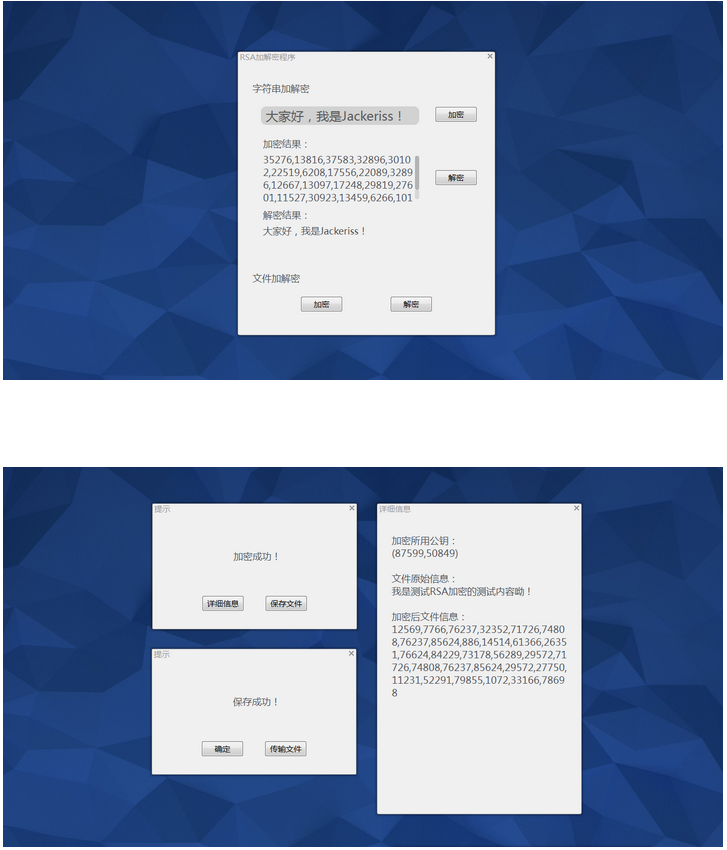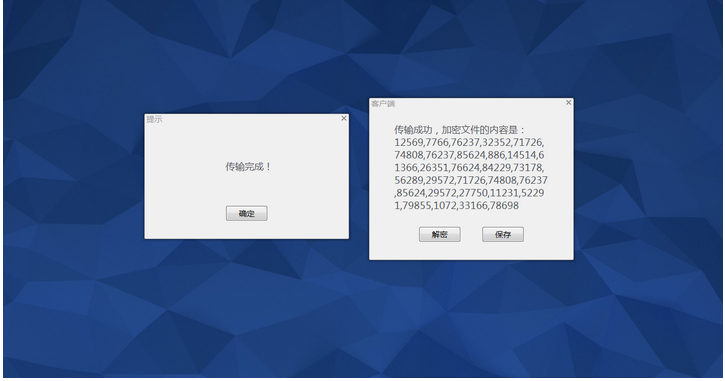Home >Backend Development >Python Tutorial >python实现RSA加密(解密)算法
python实现RSA加密(解密)算法
- WBOYWBOYWBOYWBOYWBOYWBOYWBOYWBOYWBOYWBOYWBOYWBOYWBOriginal
- 2016-06-10 15:06:042295browse
RSA是目前最有影响力的公钥加密算法,它能够抵抗到目前为止已知的绝大多数密码攻击,已被ISO推荐为公钥数据加密标准。
今天只有短的RSA钥匙才可能被强力方式解破。到2008年为止,世界上还没有任何可靠的攻击RSA算法的方式。只要其密钥的长度足够长,用RSA加密的信息实际上是不能被解破的。但在分布式计算和量子计算机理论日趋成熟的今天,RSA加密安全性受到了挑战。
RSA算法基于一个十分简单的数论事实:将两个大素数相乘十分容易,但是想要对其乘积进行因式分解却极其困难,因此可以将乘积公开作为加密密钥。


核心代码:
# -*- encoding:gbk -*- import math,random#导入模块 def prime_num(max_num):#生成小于max_num的素数列表 prime_num=[] for i in xrange(2,max_num): temp=0 sqrt_max_num=int(math.sqrt(i))+1 for j in xrange(2,sqrt_max_num): if i%j==0: temp=j break if temp==0: prime_num.append(i) return prime_num def rsa_key():#生成密钥的函数 prime=prime_num(400)#小于400的素数列表 p=random.choice(prime[-50:-1])#从后50个素数中随机选择一个作为p q=random.choice(prime[-50:-1])#从后50个素数中随机选择一个作为q while(p==q):#如果p和q相等则重新选择 q=random.choice(prime[-50:-1]) N=p*q r=(p-1)*(q-1) r_prime=prime_num(r) e=random.choice(r_prime)#随机选一个素数 d=0 for n in xrange(2,r): if (e*n)%r==1: d=n break return ((N,e),(N,d)) def encrypt(pub_key,origal):#生成加密用的公钥 N,e=pub_key return (origal**e)%N def decrypt(pri_key,encry):#生成解密用的私钥 N,d=pri_key return (encry**d)%N
下面一段代码给大家介绍python_rsa加密解密
使用python进行rsa加密与加密,包括公钥加密私钥解密,私钥加密公钥解密。(需要安装M2Crypto库)。
代码:
#!/usr/bin/env python
#encoding=utf-8
'''
测试rsa加密解密
'''
from M2Crypto import RSA
msg = 'aaaa-aaaa'
rsa_pub = RSA.load_pub_key('rsa_pub.pem')
rsa_pri = RSA.load_key('rsa_pri.pem')
print '*************************************************************'
print '公钥加密,私钥解密'
ctxt = rsa_pub.public_encrypt(msg, RSA.pkcs1_padding)
ctxt64 = ctxt.encode('base64')
print ('密文:%s'% ctxt64)
rsa_pri = RSA.load_key('rsa_pri.pem')
txt = rsa_pri.private_decrypt(ctxt, RSA.pkcs1_padding)
print('明文:%s'% txt)
print '*************************************************************'
print '私钥加密,公钥解密'
ctxt_pri = rsa_pri.private_encrypt(msg, RSA.pkcs1_padding)
ctxt64_pri = ctxt.encode('base64')
print ('密文:%s'% ctxt64_pri)
txt_pri = rsa_pub.public_decrypt(ctxt_pri, RSA.pkcs1_padding)
print('明文:%s'% txt_pri)
库的安装说明
M2Crypto库的下载地址:
https://github.com/martinpaljak/M2Crypto
或者:https://pypi.python.org/pypi/M2Crypto
依赖的库:openssh-devel gcc swig (这3个库在centos上可以直接使用yum安装)
Statement:
The content of this article is voluntarily contributed by netizens, and the copyright belongs to the original author. This site does not assume corresponding legal responsibility. If you find any content suspected of plagiarism or infringement, please contact admin@php.cn
Previous article:Using Django with GAE Python 后台抓取多个网站的页面全文Next article:python编码最佳实践之总结

